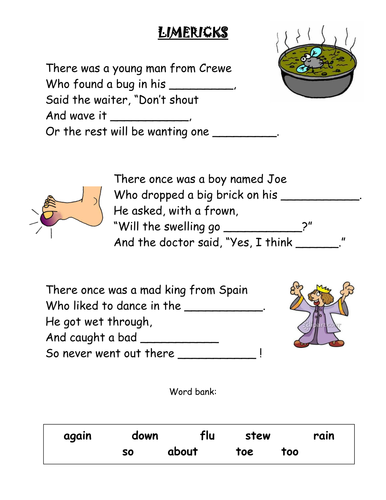What is a Limerick?
Limericks are short, usually funny poems. No one knows for sure where the name “limerick” comes from, but most people assume it is related to County Limerick.
Limericks have a distinct rhythm which you can pick up if you read it out loud.
Watch this useful video on how to write limericks.
This link is really useful too. https://www.wikihow.com/Write-a-Limerick
The Rules of Limericks
Limericks, like all poetic forms, have a set of rules that you need to follow. The rules for a limerick are fairly simple:
- They are five lines long.
- Lines 1, 2, and 5 rhyme with one another.
- Lines 3 and 4 rhyme with each other.
- They have a distinctive rhythm
- They are usually funny.
Some Limerick Tricks
There are two more things that you will notice when you read limericks:
- The first line usually ends with a person’s first name or the name of a place.
- The last line is usually funny.
Because the first line is usually the name of a person or place, writing the first line is the easiest part. You simply pick the name of a place or person – like “New York” or “Dave” – and write a line like this:
There once was a man from New York
Now list words that rhyme with York, for example “cork,” “fork,” “pork,” “stork,
OR
There was an old woman named Dave
Again list words that rhyme with Dave such as “cave,” “gave,” “wave,” . You could even get away with a word like “bathe”.
Here’s my attempt. The letters in capitals show the beat if you read it loud.
There WAS an old WOMan named DAVE
Who refUSED to reTURN a WAVE
When they ASKED her WHY
She repPLIED with a CRY
“‘Tis the NAME that my MUM and dad GAVE.”
Your Turn
Now it’s your turn to see if you can write a limerick of your own. Remember to follow these steps:
- Choose the name of a person or place and write the first line.
- Look in a rhyming dictionary for words that rhyme with your person or place name.
- Write line 2 and 5 to rhyme with the first line.
- Now write lines 3 and 4 with a different rhyme.
When you are done writing, read your limerick out loud to see if it has the right rhythm; three “beats” on lines 1, 2, and 5, and two “beats” on lines 3 and 4, as shown above. If not, see if you can rewrite some words to get the rhythm right.
Fill in the blanks below for a little bit of practice.

Limericks Take Practice
I know that writing limericks may seem tricky at first. But, with a little practice, you’ll soon be creating funny limericks of your own that will make us all laugh. Have fun!

